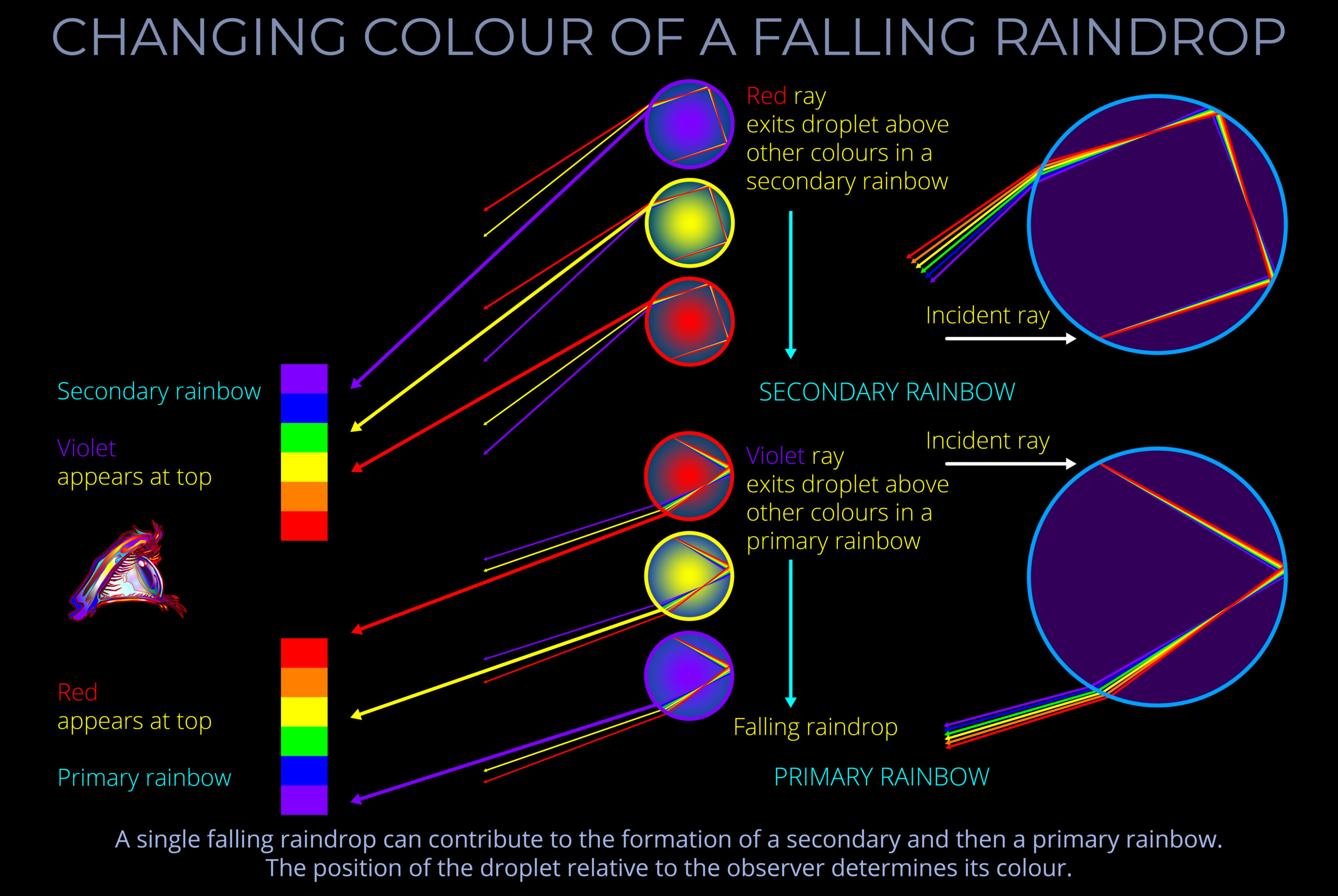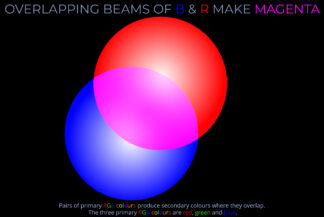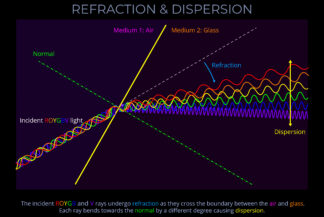Changing Colour of a Falling Raindrop
£0.00
This is one of a set of almost 40 diagrams exploring Rainbows.
Each diagram appears on a separate page and is supported by a full explanation.
- Follow the links embedded in the text for definitions of all the key terms.
- For quick reference don’t miss the summaries of key terms further down each page.
Description
Changing Colour of a Falling Raindrop
TRY SOME QUICK QUESTIONS AND ANSWERS TO GET STARTED
About the diagram
About the diagram
- This diagram has four sections:
- The top left and top right deal with the colour of a single raindrop as it falls through a secondary rainbow. The left-hand side shows that the raindrop changes colour from violet to red as it falls. The right-hand side shows that to be visible in a secondary rainbow, light must enter the lower half of a raindrop and be reflected twice before exiting towards an observer.
- The bottom left and bottom right deal with the colour of a single raindrop as it falls through a primary rainbow. The left-hand side shows that the raindrop changes colour from red to violet as it falls. The right-hand side shows that to be visible in a primary rainbow, light must enter the top half of a raindrop and be reflected once before exiting towards an observer.
- So this is the sequence:
- A single raindrop changes colour over time and as it falls. Its colour at any moment depends on its angular distance from the axis of the rainbow.
- At its largest angular distance from the axis, a raindrop appears violet to an observer as it enters into the outer edge of a secondary rainbow.
- Moments later, as that same raindrop falls, and its angular distance decreases, it changes colour, first from violet to blue and finally to red. The diagram shows the moments at which it appears violet, yellow and red.
- During this phase, light reflected towards the observer is entering the lower half of the droplet and reflects off the inside twice before exiting.
- As the angular distance reduces further the droplet disappears for a moment as it enters Alexander’s band.
- As it falls further and its angular distance reaches 42.40 it enters the outer edge of the primary rainbow and appears red and then finally violet as it exits the inside edge.
- The droplet is now almost invisible but continues to contribute a little to a scattering of light that fills the area within the arcs of the two bows.
Overview of primary rainbows
Overview of secondary rainbows
Some key terms
A secondary rainbow is formed when sunlight undergoes two internal reflections within water droplets, creating an arc with colours reversed from the primary rainbow (violet on the outside, red on the inside). It appears larger and fainter due to light loss during the second reflection and a broader spread of wavelengths.
- A secondary rainbow appears when sunlight is refracted as it enters raindrops, reflects twice off the inside surface, is refracted again as it escapes back into the air, and then travels towards an observer.
- A secondary rainbow always appears alongside a primary rainbow and forms a larger arc with the colours reversed.
- A secondary rainbow has violet on the outside and red on the inside of the bow.
- When both primary and secondary bows are visible they are often referred to as a double rainbow.
- A secondary rainbow forms at an angle of between approx. 50.40 to 53.40 to its centre as seen from the point of view of the observer.
Rainbow colours are the colours seen in rainbows and in other situations where visible light separates into its different wavelengths and the spectral colours corresponding with each wavelength become visible to the human eye.
- The rainbow colours (ROYGBV) in order of wavelength are red (longest wavelength), orange, yellow, green, blue and violet (shortest wavelength).
- It is the sensitivity of the human eye to this small part of the electromagnetic spectrum that results in our perception of colour.
- The names of rainbow colours are a matter more closely related to the relationship between perception and language than anything to do with physics or scientific accuracy. While the spectrum of light and the colours we see are both determined by wavelength, it’s our eyes and brains that turn these differences in light into the colours we experience.
- In the past, rainbows were sometimes portrayed as having seven colours: red, orange, yellow, green, blue, indigo and violet.
- Modern portrayals of rainbows reduce the number of colours to six spectral colours, ROYGBV.
- In reality, the colours of a rainbow form a continuous spectrum and there are no clear boundaries between one colour and the next.
A rainbow is an optical effect produced by illuminated droplets of water. Rainbows are caused by reflection, refraction and dispersion of light in individual droplets and result in the appearance of an arc of spectral colours.
A primary rainbow is formed when sunlight is refracted and reflected by water droplets in the air. The colours of a primary rainbow are always in the same order, with red on the outside and violet on the inside.
- A primary rainbow appears when sunlight is refracted as it enters raindrops, reflects once off the opposite interior surface, is refracted again as it escapes back into the air, and then travels towards an observer.
- The colours in a primary rainbow are always arranged with red on the outside of the bow and violet on the inside.
- The outside (red) edge of a primary rainbow forms an angle of approx. 42.40 from its centre, as seen from the point of view of the observer. The inside (violet) edge forms at an angle of approx. 40.70.
- To get a sense of where the centre of a rainbow might be, imagine extending the curve of a rainbow to form a circle.
- If your shadow is visible as you look at a rainbow its centre is aligned with your head.
- A primary rainbow is only visible when the altitude of the sun is less than 42.4°.
- Primary bows appear much brighter than secondary bows and so are easier to see.
- The curtain of rain on which sunlight falls is not always large enough or in the right place to produce both primary and secondary bows.



